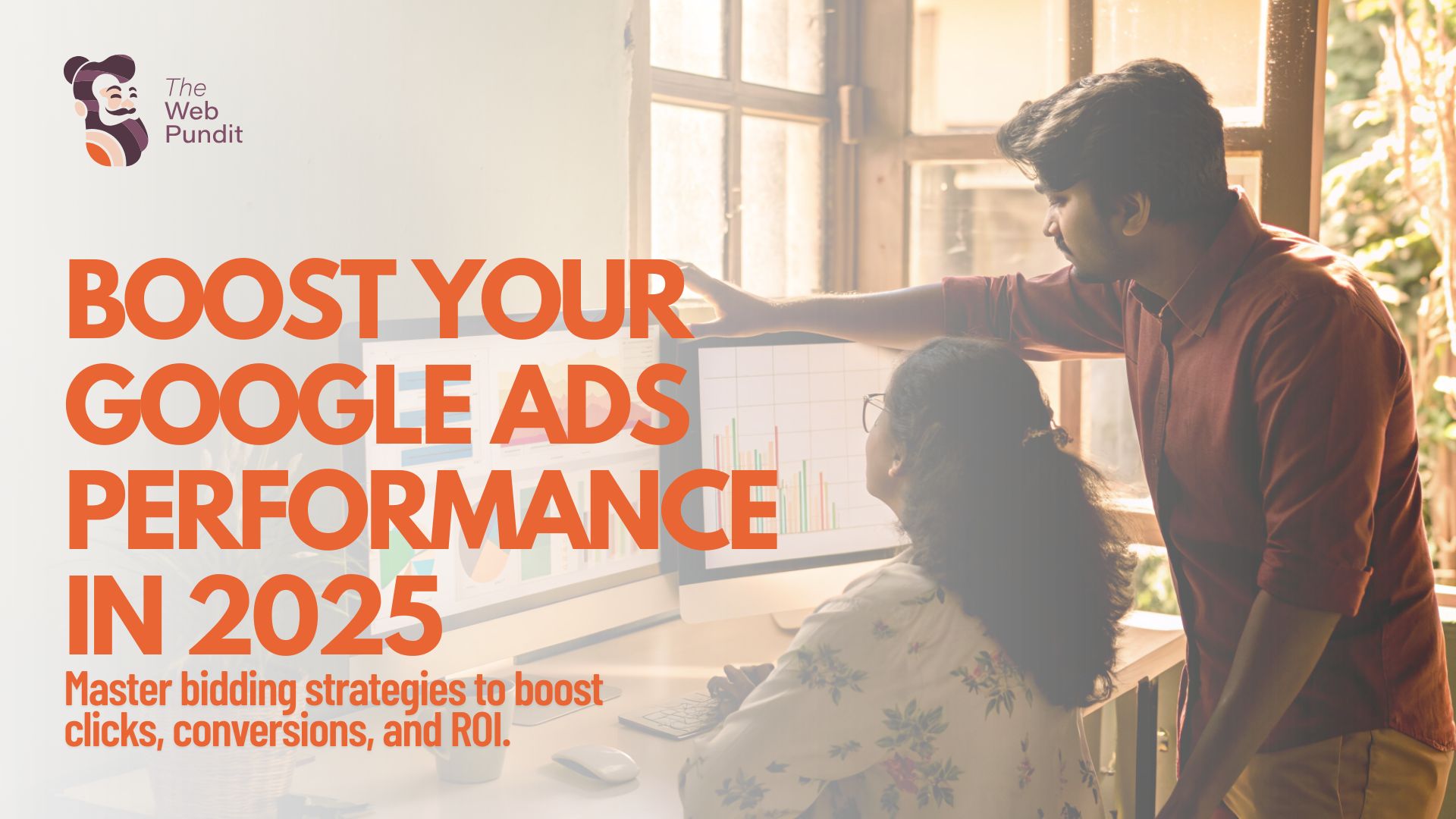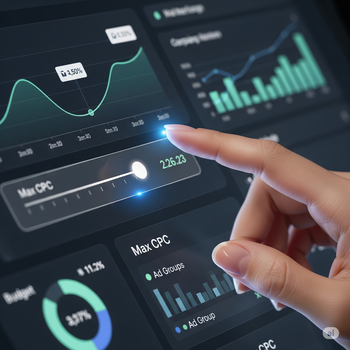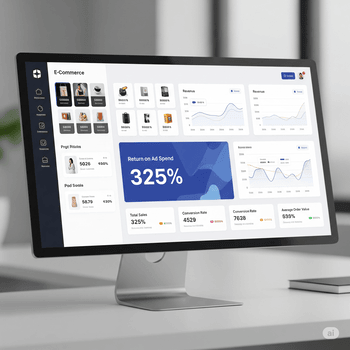7 Best Google Ads Bidding Strategies for Higher Conversions in 2025
Discover the top Google Ads bidding strategies in 2025. Learn how to use Manual CPC, Target CPA, Maximize Clicks, and Target ROAS to boost ad performance, reduce costs, and achieve business goals.

If you’ve ever run a Google Ads campaign and wondered why the clicks are rolling in but the conversions aren’t, here’s a hard truth, your Google Ads bidding strategy might be the missing puzzle piece.
So, what is bidding strategy in Google Ads?
In simple terms, it’s the set of rules you give Google on how much you’re willing to pay for a click, conversion, or impression. But it’s more than just numbers, it’s about telling Google’s algorithm how to prioritize your money so you’re not just getting traffic, you’re getting results that matter.
Think of it like this: your bidding strategy is the GPS for your ad budget. Without it, you’re just driving aimlessly, burning fuel (and cash) without a clear route to your destination.
And here’s where 2025 changes the game.
The right Google Ads bidding strategies aren’t just about throwing money at keywords anymore, they’re about spending strategically. With Google’s AI-powered automation and machine learning, bids are now optimized in real-time. This means your ads can appear to the right audience, at the right time, and at the right cost, without you having to manually tweak bids every hour.
Done right, your bidding strategy becomes your campaign’s secret weapon, helping you lower costs, improve ad rankings, and maximize ROI without increasing your budget. Done wrong? You might as well be leaving money on the table.
How Google Ads Bidding Works

Before we dive into the best bidding strategies in Google Ads, let’s quickly understand the basics.
Google runs an auction every time someone searches for a keyword you’re targeting. Your ad’s position depends on three main factors:
In short: It’s not just your bid amount that matters, relevance and quality play a huge role in winning auctions at the lowest cost.
Manual vs. Automated Bidding

One of the first choices advertisers face is: Should I control my bids manually or let Google’s AI handle them?
In 2025, automated google ads bidding strategies dominate because they leverage machine learning to adjust bids per auction. But manual bidding still has its place for advertisers who want maximum control.
7 Best Google Ads Bidding Strategies for Higher Conversions
These Google Ads bidding strategies aren’t just textbook jargon, they’re tried, tested, and proven methods that marketers (including us at The Web Pundit) use daily to drive measurable results.
The beauty is, no matter your business size or budget, there’s a bidding strategy that can work for you. Whether you want to maximize visibility, drive high-intent clicks, or squeeze the most ROI from every rupee spent, the right strategy can transform your campaigns from “just running” to “actually converting.”
1. Maximize Conversions

What it is:
An automated bidding strategy where Google sets your bids to get you as many conversions as possible within your budget.
When to use it:
- You’re launching a new campaign and don’t have much historical conversion data.
- You want quick results without manually adjusting bids every day.
How to set it up:
- Go to your campaign settings.
- Select Bidding → Change bid strategy → Maximize Conversions.
- Ensure conversion tracking is set up, without it, Google can’t optimize properly.
Pros:
- Fully automated and timesaving.
- Great for data gathering in the first 30 days.
Cons:
- No control over CPC, costs can spike if competition is high.
- Works best with budget flexibility.
Pro Tip: If you see CPCs rising too much, consider setting a max CPC limit (available in some accounts) to control spend.
2. Target CPA (Cost Per Acquisition)

What it is:
You tell Google how much you’re willing to pay for a conversion, and it adjusts bids to hit that target.
When to use it:
- You have a steady stream of conversions (30–50 per month minimum).
- You want predictable cost per conversion.
How to set it up:
- Switch your bidding strategy to Target CPA.
- Start with a CPA slightly higher than your current average.
- Lower the target gradually as performance improves.
Pros:
- More control over cost efficiency.
- Works well for lead generation and e-commerce.
Cons:
- Too low CPA targets can hurt volume.
- Requires strong conversion tracking and historical data.
Pro Tip: Pair Target CPA with remarketing campaigns for warmer audiences, they’re more likely to convert at lower costs.
3. Target ROAS (Return on Ad Spend)

What it is:
Focuses on maximizing the value of conversions rather than just their number. You set a desired return percentage, and Google bids to achieve it.
When to use it:
- You run an e-commerce store.
- Your products/services have varying profit margins.
How to set it up:
- Ensure conversion values are being tracked in Google Ads.
- Choose Target ROAS as your bidding strategy.
- Set a ROAS target (e.g., 500% = ₹5 return for every ₹1 spent).
Pros:
- Prioritizes profitable conversions.
- Let's you focus on the budget for high-value buyers.
Cons:
- Needs accurate value tracking, wrong data = wrong bidding.
- Works best for accounts with 50+ value-tracked conversions per month.
Pro Tip: Use this strategy in campaigns that already have stable conversion data, otherwise, results may fluctuate.
4. Maximize Conversion Value
What it is:
Similar to Target ROAS but without a strict percentage goal, Google simply tries to get the highest possible total conversion value within your budget.
When to use it:
- You want to prioritize bigger-ticket sales.
- You’re okay with conversion volume being lower if value is higher.
How to set it up:
- Track conversion values in your Google Ads account.
- Select Maximize Conversion Value as your strategy.
Pros:
- Perfect for businesses where some conversions are worth far more.
- Simple to set up if value tracking is already enabled.
Cons:
- Can lead to fewer conversions if high-value ones dominate.
- Not suitable if all conversions have similar value.
Pro Tip: Combine with audience targeting for high-intent buyers (e.g., cart abandoners, loyal customers).
5. Enhanced CPC (ECPC)
What it is:
A hybrid between manual and automated bidding. You set bids manually, but Google can raise or lower them slightly to improve conversion chances.
When to use it:
- You’re transitioning from manual bidding to automation.
- You want some automation but still keep control.
How to set it up:
- Keep Manual CPC as your base.
- Enable Enhanced CPC in your campaign settings.
Pros:
- Safer than going fully automated.
- Helps you learn how Google’s automation behaves.
Cons:
- Won’t optimize as aggressively as full automation.
- Still needs manual monitoring.
Pro Tip: Use ECPC on your highest-performing keywords to squeeze more conversions without losing control.
6. Manual CPC with Conversion Tracking
What it is:
You decide exactly how much to bid for each keyword and adjust based on performance data.
When to use it:
- You have a niche market with very specific keyword intent.
- You’re running a low-volume, high-value campaign.
How to set it up:
- Select Manual CPC as your bidding strategy.
- Turn on conversion tracking to guide optimizations.
- Regularly adjust bids based on cost-per-conversion data.
Pros:
- Maximum control.
- Great for advertisers with advanced PPC skills.
Cons:
- Time-consuming to manage.
- Easy to overpay if not careful.
Pro Tip: This is best for small-scale campaigns or high-ticket niches where every click matters.
7. Portfolio Bid Strategies
What it is:
Lets you apply one bidding strategy across multiple campaigns, ad groups, or keywords for unified optimization.
When to use it:
- You manage multiple campaigns with similar goals.
- You want to streamline bidding without micro-managing each campaign.
How to set it up:
- Go to Shared Library → Bid Strategies.
- Create a new portfolio strategy and assign campaigns to it.
Pros:
- Saves time on large accounts.
- Ensures consistent bidding logic.
Cons:
- May not work if campaigns have vastly different performance patterns.
Pro Tip: Use for campaigns in the same funnel stage or with similar audience targeting.
Comparison Table – Google Ads Bidding Strategies
Best Practices

Now that you know your bidding options, here’s how to maximize performance with the right setup and ongoing adjustments.
1. Set Clear Goals Before You Choose
Your bidding strategy should match your campaign objective.
Example:
- If your goal is brand awareness, you might choose Maximize Clicks to get more traffic.
- If your goal is sales or leads, you might go for Target CPA or Target ROAS.
2. Ensure Conversion Tracking is Rock-Solid
Without accurate conversion tracking, Google Ads’ automated bidding can’t optimize effectively.
- Use Google Tag Manager for clean, centralized tracking.
- Track not just purchases, but micro-conversions (sign-ups, downloads, cart adds).
3. Align Bidding with Funnel Stage
Different funnel stages require different bidding intensity.
4. Use Seasonal Bid Adjustments
Your audience’s buying behavior changes around festivals, sales events, or launches.
- Example: Increase bids by 25% during Diwali week for e-commerce.
- Reduce bids in off-season to save budget.
5. Leverage Remarketing
Returning visitors often have higher purchase intent, bid more aggressively for them.
- Use RLSA (Remarketing Lists for Search Ads) to boost bids by 20–50% for past visitors.
- Example: An online store could bid higher for users who abandoned carts.
9 Pro Tips to Boost Results
Final Takeaway
There’s no one-size-fits-all bidding strategy. The right choice depends on:
- Your business goals
- Your budget size
- The amount and quality of your conversion data
If you want to squeeze every last conversion from your budget, test different bidding strategies, track results, and adjust regularly.
Pro Tip: If you’re not sure where to start, we at The Web Pundit can help you pick, test, and fine-tune a bidding strategy that turns ad clicks into real customers.

